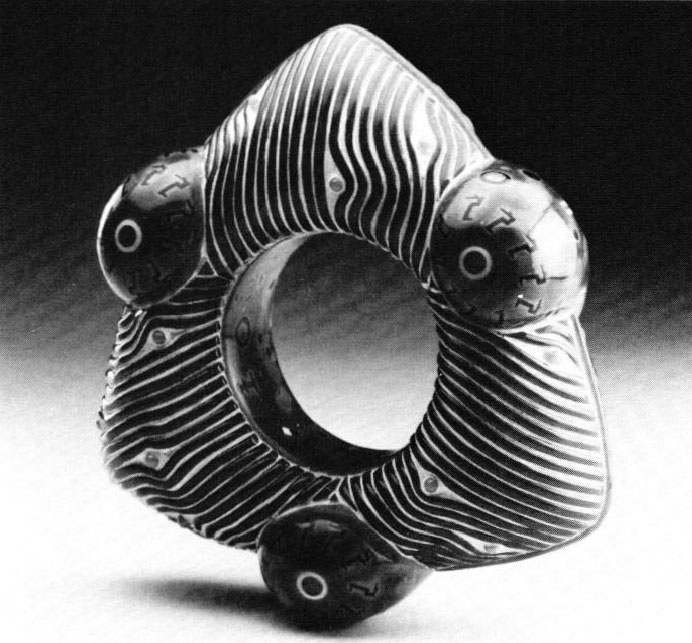Ornamenta 1: Jewelry Classifications
3 Minute Read
To commit oneself in the jungle of jewelry classifications, categories and specification; to express an absolutely clear definition is an extremely difficult venture. There is costume jewelry, gem-set jewelry, designers' jewelry, gold jewelry, genuine jewelry, fake jewelry, imitation jewelry, folklore jewelry, commercial "normal" jewelry, fantasy jewelry, artistic jewelry - jewelry art.
The finance authorities know, they must define types - taxes depend on it. Civil servants simply open their "Worterbuch der Kunst" (1966) by Johannes Jahn and look under "arts and crafts." There they determine all branches of art fall under that definition that do not lend form to imagination and do not exist for their own sake - in other words, "arts and crafts" encompasses all those areas that lend beauty to the practicality of an object by simply artistically designing and forming it.
Jewelry enhances human worth. Does the person himself, then, become a work of art, or just the "thing" with which he adorns himself? From the standpoint of architecture, the problem looks quite different. "The function of embellishment wanes in face of an aesthetic, symbolic and magic significance. Compared to architecture in the grip of functionalism, jewelry has the freedom of the a functional" (Günther Feuerstein). Perhaps the problem can be solved by the confrontation of the unique with multiples.
According to Walter Benjamin, a work of art obtains its unique value from its original and genuine usefulness in ritual. Secularization drives art further into the profane service of beauty. The possibility of reproduction on a grand scale evokes the contradictory movement of l'art pour l'art, which rejects social function as well as concrete practicality. "The technical ability to reproduce works of art freed them from their parasitical existence in ritual. Further, the possibility of reproduction becomes more and more the reproduction of a work of art especially wrought for that purpose" (Walter Benjamin, about 1930).
What help for the goldsmith, after the technical ability to reproduce works of art has so altered the traditional respect for his profession and the whole professional picture? In any case, the loss of status in society was the basis for the development of new paths: On the one hand there is the possibility to achieve respect as an artist. Concepts such as "unique piece" assure the association with art, the emphasis is on handicraft. But the traditional goldsmith gets caught in a conflict with the prevailing concept of art as removed from practical artifacts.
On the other hand, today's goldsmith becomes creator/designer in the jewelry industry and his individual style is doomed to lose itself to the anonymity of mass production. The personal "signature" is missing on these pieces, which are exactly alike. Artists lend their names (which stand for uniqueness, specialness, originality) to these products and in this dire manner increase their value.
Jewelry art should be seen in the same light as furniture - as objects of art. They have their contemporary status. Industrial and communications artists/designers fought for that successfully; their art objects have the go-ahead. They "are the unbroken reaction to hopes, fears and the subjectivity of the times: they are seismographs of social controversy and the way out of everyday commercialization. They serve more the forethought given to possibilities than the confirmation of necessity" (Christian Borngräber, 1987). And in jewelry is found the manifestation of the artistic determination to open boundaries, to blast away categories, to undermine the possibilities of classification, to block specifications.
Let us create gardens rather than new boxes. Only then will jewelry be freed from old illusions of form, function, material and values. Free of handed-down dependencies there is suddenly room - with no ultimate definition for jewelry, an art like any other.
Veroknika Schwarzinger, V&V Galerie, Vienna. Schwarzinger was originally a member of the "Ornamenta 1" advisory board.
Text originally published in the "Ornamenta 1" organizing committee booklet.
Related Articles:
- The Anatomy of Ornamenta 1
- The Economics of Ornamenta 1
- Ornamenta 1 : International Exhibition of Contemporary Jewelry
You assume all responsibility and risk for the use of the safety resources available on or through this web page. The International Gem Society LLC does not assume any liability for the materials, information and opinions provided on, or available through, this web page. No advice or information provided by this website shall create any warranty. Reliance on such advice, information or the content of this web page is solely at your own risk, including without limitation any safety guidelines, resources or precautions, or any other information related to safety that may be available on or through this web page. The International Gem Society LLC disclaims any liability for injury, death or damages resulting from the use thereof.
The All-In-One Jewelry Making Solution At Your Fingertips
When you join the Ganoksin community, you get the tools you need to take your work to the next level.
Trusted Jewelry Making Information & Techniques
Sign up to receive the latest articles, techniques, and inspirations with our free newsletter.
